Of the origin of the Hound of the Baskervilles there have been many statements, yet as I come in a direct line from Hugo Baskerville, and as I had the story from my father, who also had it from his, I have set it down with all belief that it occurred even as is here set forth. And I would have you believe, my sons, that the same Justice which punishes sin may also most graciously forgive it, and that no ban is so heavy but that by prayer and repentance it may be removed. Learn then from this story not to fear the fruits of the past, but rather to be circumspect in the future, that those foul passions whereby our family has suffered so grievously may not again be loosed to our undoing.It was years before I became a member of the Los Angeles Chapter of The Baker Street Irregulars, when I first read the above words in Sir Arthur Conan Doyle's "The Hound of the Baskervilles". Probably the most recognized of the four novels and 56 short mysteries the physician turned writer created about "The World's First Consulting Detective"
Although the first appearance of "Sherlock Holmes" and "Dr. John H. Watson", late of Queen Victoria's Indian Afghan Army's Medical Corps had an equally enticing title, "A STUDY IN SCARLET", about a murder of revenge. It is the tale about:
THE HOUND OF HELL!
That caught the imaginations of both readers and viewers of the motion picture and television treatments of the novel. I don't believe there is another novel, or story that has been remade as many times as this work. 35 to be exact as of this writing.
The following is a look at all those productions about "Sir Henry Baskerville", heir, or cursed decedent of "Sir Hugo",
BUT FIRST A BRIEF SHERLOCK HOLMES HISTORY LESSON
The American Stage Actor William Gillette set the costume everyone associates with "Sherlock Holmes" of a deerstalker hat and meerschaum curved pipe.


Gillette had used the deerstalker to be seen more clearly in the back rows of the balcony in the theaters he played and the specific type of pipe. So he could actually speak his lines with it in his mouth.

Sir Arthur Conan Doyle always wrote that the favorite pipe used by "Sherlock Holmes" was made of cherry wood and that he normally wore a soft felt hat. Exactly what the author used as portrayed above.
The illustrator for “The Strand Magazine”, Sidney Paget, started using photos of Gillette as part of his a model for his drawings, but also a little bit of himself.
Here is the classic pose of "Sherlock Holmes" by Paget.

The following drawing shows "Holmes" in classic William Gillette/Paget form as he speaks to "Watson".
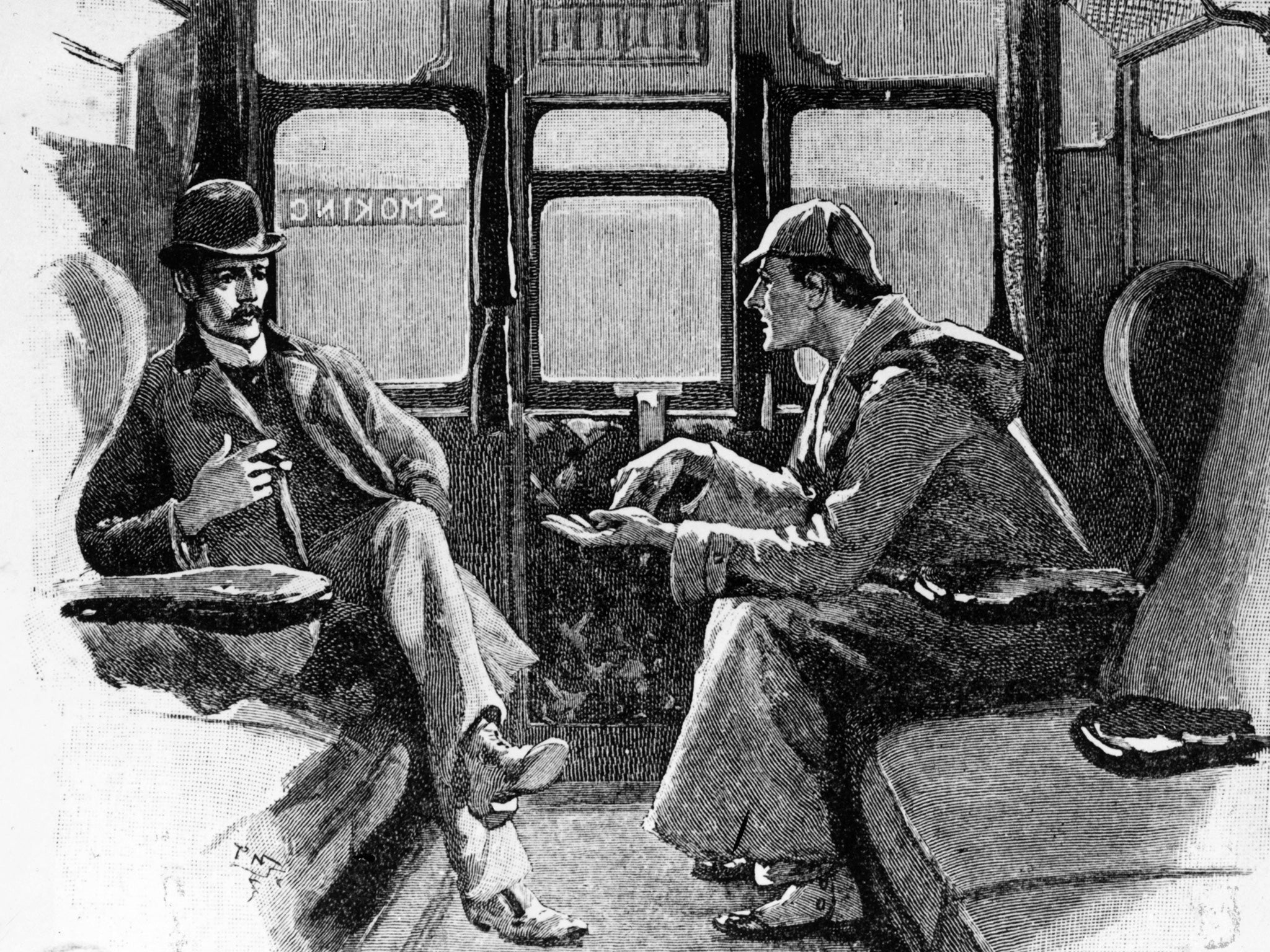
Keeping in mind the Paget illustrations are known World Wide and the style often copies in illustrated editions of the "Sherlock Holmes" stories. The question more appropriate to this article is:
Gillette had used the deerstalker to be seen more clearly in the back rows of the balcony in the theaters he played and the specific type of pipe. So he could actually speak his lines with it in his mouth.
Sir Arthur Conan Doyle always wrote that the favorite pipe used by "Sherlock Holmes" was made of cherry wood and that he normally wore a soft felt hat. Exactly what the author used as portrayed above.
The illustrator for “The Strand Magazine”, Sidney Paget, started using photos of Gillette as part of his a model for his drawings, but also a little bit of himself.
Here is the classic pose of "Sherlock Holmes" by Paget.
The following drawing shows "Holmes" in classic William Gillette/Paget form as he speaks to "Watson".

WHO FIRST PLAYED SHERLOCK HOLMES ON THE MOTION PICTURE SCREEN?
That answer might surprise my reader.
Below is a scene from the first filmed "Sherlock Holmes" mystery entitled "The $500 Reward". The actor portraying the "World's First Consulting Detective", in this 1911 silent short comedy film, was future director Mack Sennett. Who created "The Keystone Cops" and "The Little Rascals" aka: "Our Gang". I bring this up, because many actors would portray the Detective, but few looked like the drawings. In the photo on Sennett's left is actor Fred Mace as "Dr. Watson" holding his pistol.

The story of the Baskerville's started in August of 1901.

THE CURSE OF THE BASKERVILLE FAMILY ON THE MOTION PICTURE AND TELEVISION SCREENS
I continue with the reading of the Legend as told to "John H. Watson, M.D." and "Mr. Sherlock Holmes" by "Dr. James Mortimer M,R,C,S,.
Know then that in the time of the Great Rebellion (the history of which by the learned Lord Clarendon I most earnestly commend to your attention) this Manor of Baskerville was held by Hugo of that name, nor can it be gainsaid that he was a most wild, profane, and godless man. This, in truth, his neighbours might have pardoned, seeing that saints have never flourished in those parts, but there was in him a certain wanton and cruel humour which made his name a byword through the West. It chanced that this Hugo came to love (if, indeed, so dark a passion may be known under so bright a name) the daughter of a yeoman who held lands near the Baskerville estate. But the young maiden, being discreet and of good repute, would ever avoid him, for she feared his evil name. So it came to pass that one Michaelmas this Hugo, with five or six of his idle and wicked companions, stole down upon the farm and carried off the maiden, her father and brothers being from home, as he well knew. When they had brought her to the Hall the maiden was placed in an upper chamber, while Hugo and his friends sat down to a long carouse, as was their nightly custom. Now, the poor lass upstairs was like to have her wits turned at the singing and shouting and terrible oaths which came up to her from below, for they say that the words used by Hugo Baskerville, when he was in wine, were such as might blast the man who said them. At last in the stress of her fear she did that which might have daunted the bravest or most active man, for by the aid of the growth of ivy which covered (and still covers) the south wall she came down from under the eaves, and so homeward across the moor, there being three leagues betwixt the Hall and her father's farm. "It chanced that some little time later Hugo left his guests to carry food and drink -- with other worse things, perchance -- to his captive, and so found the cage empty and the bird escaped. Then, as it would seem, he became as one that hath a devil, for, rushing down the stairs into the dining-hall, he sprang upon the great table, flagons and trenchers flying before him, and he cried aloud before all the company that he would that very night render his body and soul to the Powers of Evil if he might but overtake the wench. And while the revellers stood aghast at the fury of the man, one more wicked or, it may be, more drunken than the rest, cried out that they should put the hounds upon her Whereat Hugo ran from the house, crying to his grooms that they should saddle his mare and unkennel the pack, and giving the hounds a kerchief of the maid's, he swung them to the line, and so off full cry in the moonlight over the moor. "Now, for some space the revellers stood agape, unable to understand all that had been done in such haste. But anon their bemused wits awoke to the nature of the deed which was like to be done upon the moorlands. Everything was now in an uproar, some calling for their pistols, some for their horses, and some for another flask of wine. But at length some sense came back to their crazed minds, and the whole of them, thirteen in number, took horse and started in pursuit. The moon shone clear above them, and they rode swiftly abreast, taking that course which the maid must needs have taken if she were to reach her own home. "They had gone a mile or two when they passed one of the night shepherds upon the moorlands, and they cried to him to know if he had seen the hunt. And the man, as the story goes, was so crazed with fear that he could scarce speak, but at last he said that he had indeed seen the unhappy maiden, with the hounds upon her track. 'But I have seen more than that,' said he, 'for Hugo Baskerville passed me upon his black mare, and there ran mute behind him such a hound of hell as God forbid should ever be at my heels.' So the drunken squires cursed the shepherd and rode onward. But soon their skins turned cold, for there came a galloping across the moor, and the black mare, dabbled with white froth, went past with trailing bridle and empty saddle. Then the revellers rode close together, for a great fear was on them, but they still followed over the moor, though each, had he been alone, would have been right glad to have turned his horse's head. Riding slowly in this fashion they came at last upon the hounds. These, though known for their valour and their breed, were whimpering in a cluster at the head of a deep dip or goyal, as we call it, upon the moor, some slinking away and some, with starting hackles and staring eyes, gazing down the narrow valley before them. "The company had come to a halt, more sober men, as you may guess, than when they started. The most of them would by no means advance, but three of them, the boldest, or it may be the most drunken, rode forward down the goyal. Now, it opened into a broad space in which stood two of those great stones, still to be seen there, which were set by certain forgotten peoples in the days of old. The moon was shining bright upon the clearing, and there in the centre lay the unhappy maid where she had fallen, dead of fear and of fatigue. But it was not the sight of her body, nor yet was it that of the body of Hugo Baskerviile lying near her, which raised the hair upon the heads of these three daredevil roysterers, but it was that, standing over Hugo, and plucking at his throat, there stood a foul thing, a great, black beast, shaped like a hound, yet larger than any hound that ever mortal eye has rested upon. And even as they looked the thing tore the throat out of Hugo Baskerville, on which, as it turned its blazing eyes and dripping jaws upon them, the three shrieked with fear and rode for dear life, still screaming, across the moor. One, it is said, died that very night of what he had seen, and the other twain were but broken men for the rest of their days. "Such is the tale, my sons, of the coming of the hound which is said to have plagued the family so sorely ever since. If I have set it down it is because that which is clearly known hath less terror than that which is but hinted at and guessed. Nor can it be denied that many of the family have been unhappy in their deaths, which have been sudden, bloody, and mysterious. Yet may we shelter ourselves in the infinite goodness of Providence, which would not forever punish the innocent beyond that third or fourth generation which is threatened in Holy Writ. To that Providence, my sons, I hereby commend you, and I counsel you by way of caution to forbear from crossing the moor in those dark hours when the powers of evil are exalted.
"The Hound of the Baskervilles" was written after "Sherlock Homes" had been killed. Along with his arch enemy Mathematician and Crime Czar "Professor James Moriarty". Both men apparently falling to their death's over the Reichenbach Falls during a fight.

The falls used by Conan Doyle are an actual location on a creek called the Rychenbach in the Bernese region of Switzerland. There are actually seven in all going down seven steps. The first step, seen above, is the largest in the region and was probably the one Conan Doyle was thinking about. However, it is an interesting image thinking of "Holmes" and "Moriarty" being swept down the remaining six steps also. No wonder "Watson" felt his friend could never have survived as each step is continuously attached to the previous ones.
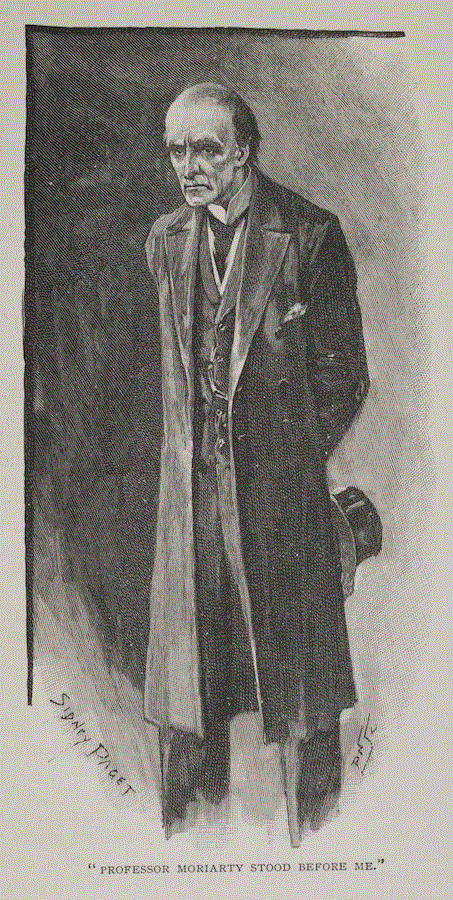
Above Sidney Pagnet's "Professor James Moriarty". I often wonder if German author Norbert Jacques modeled part of his own crime czar, "Dr. Mabuse", first brought to the motion picture screen by Fritz Lang, after "Moriarty", Although he is the one character never mentioned as a model which included even "Dr. Fu Manchu".
"The Hound of the Baskervilles" is a recollection by "Sherlock Holmes' Boswell" of a case set in their past. Rather than one of their latest exploits that "Watson" would normally relate to the British public within the pages of "The Strand Magazine". Whenever Conan Doyle called"Dr. Watson" the "Boswell" of "Sherlock Holmes". The author was referring to British biographer James Boswell, the Ninth Laird of Auchineck, born October 29, 1740, died May 19, 1795.
The first filmed version of Conan Doyle's tale was released June 12, 1914 in Germany as “Der Hund von Baskerville (The Dog of the Baskervilles)” directed by Rudolf Meinert. The first actor to play Holmes in a screen version of the story and only the second to play "Holmes" in motion pictures was Alwin NeuB (Carl Alwin Heinrich Neuss) and "strangely" "Dr. John H. Watson" was nowhere to be seen in this film.
I use the word “strangely”, because the key character in the work is not the title dog, the killer "Stapleton", or "Holmes", but "Watson". It is said that Conan Doyle did not want to write another "Sherlock Holmes" story after finally killing him off in "The Final Problem",
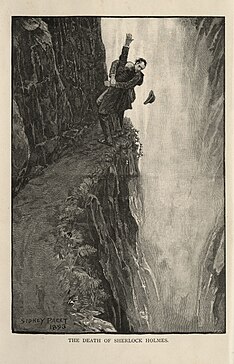
BUT the public and his publisher pressured the author. So he reluctantly wrote "The Hound of the Baskerville" with the detective only at the beginning and end. Making "Watson" that major character and satisfying both the public and publisher's requests for the return of the detective.
After determining the facts from "Dr. Mortimer" of both the death of "Sir Charles Baskerville" and the Curse. Along with meeting the heir to the estate, the now, "Sir Henry Baskerville". "Sherlock Holmes" tells "Watson", "Sir Henry" and "Dr. Mortimer" that he has matters to finish in London and sends then off together to the Baskerville Estate near the "Grimpen Mire" in Dartmoor. "Dr. Watson" is told to send "Holmes" letters to inform him of what his friend is discovering around "Baskerville Hall". This is of course a ruse. As "Sherlock Holmes" is actually on the Mire, but this will not be revealed until less than the final third of the novel.
Another major character missing in the 1914 German picture is "Beryl Stapleton". Yet, the characters of "Stapleton" and "Laura Lyons" are present. Although "Laura Lyons" has become "LORD Henry's" fiancee.
The 1914 German film was originally thought lost, but two prints have now been discovered. One with the Russian company Gosfilmofond and the other the German Filmmuseum Munchen.
Below Alwin NeuB as Sherlock Holmes. Note he has a more Conan Doyle look.
What happened next to the German Hound were three sequels entitled “Der Hund von Baskerville” 2 through 4 with their own secondary titles identifying each new story. Each of these films contained some, if not all, of the original characters in new situations.


The secondary titles in English are:
#2---The Isolated House released in 1914.#3---The Eerie Rooms released in 1914.
#4---The Legend of the Dog in 1915
In 1920, seen above, three more “sequels” to the original German film were released by the same film company as the 1914 series. Also starting out with the title “The Hound of the Baskervilles” and adding a specific subtitle as none of these were the original story. The subtitles were:
The Dark Castle
The House Without Windows
Dr. MacDonald’s Sanatorium
The House Without Windows
Dr. MacDonald’s Sanatorium
It wouldn't be until 1921, 20 years after that first “Strand Magazine” episode ran, for a U.K. studio to film the story. The Stoll Films version stared Ellie Norwood (Anthony Edward Brett) as "Holmes".


Quoting Sir Arthur Conan Doyle. The following is "Watson"s" description of the title character when with "Holmes" they first see the hound:
A hound it was, an enormous coal-black hound, but not such a hound as mortal eyes have ever seen. Fire burst from its open mouth, its eyes glowed with a smouldering glare, its muzzle and hackles and dewlap were outlined in flickering flame. Never in the delirious dream of a disordered brain could anything more savage, more appalling, more hellish be conceived than that dark form and savage face which broke upon us out of the wall of fog”
Above is that title character in the Stoll Film's production.
In 1923 Ellie Norwood would also star in a feature length version of “The Sign of Four. However it is what happened between those two films that makes Norwood special. He appeared as "Sherlock Holmes" in 45 short films for Stoll. Making Norwood the actor who has played Sir Arthur Conan Doyle’s sleuth the most times in motion picture history.
Sir Arthur Conan Doyle agreed to be part of the publicity for the "Norwood" series of films.

Hubert Willis portrayed Eille Norwood's "Dr. Watson" in all of these stories. He is seen on the left in this photo.

Of note is that "Beryl Stapleton" has a middle name of "Ducerne". Which might be a verification of of the alias used by "Rodger" and "Beryl" in the past, but that is never established.
In 1929 a German film company once more made a silent version of “Der Hund von Baskervilles”. This time "Sherlock Holmes" was portrayed by a British based American actor named Carlyle Blackwell. The reason given to cast him as "Holmes" was the Studio wanted an actor who looked close to the Nationality of "Sherlock Holmes". Even though all the other actors playing British characters were German and Blackwell's voice would not be heard.

Actor George Seroff was "Dr. Watson". and is seen with "Holmes" and "Watson" on the "Grimpen Mire" in the 1929 feature
..jpg)
In 1937 yet another version of "Der Hund von Baskerville" was released in Germany. This film starred Bruno Guttner as "Sherlock Holmes" and Fritz Odemar as "Dr. Watson".


The 1937 German film was a favorite of Adolph Hitler. A copy of the feature was found supposedly on the projector in the "The Bunker" with his body and Eva Braun's.
Actor George Seroff was "Dr. Watson". and is seen with "Holmes" and "Watson" on the "Grimpen Mire" in the 1929 feature
.
.jpg)
In 1937 yet another version of "Der Hund von Baskerville" was released in Germany. This film starred Bruno Guttner as "Sherlock Holmes" and Fritz Odemar as "Dr. Watson".


Across the English Channel the British made another version of "The Hound of the Baskervilles" six years earlier in 1931.
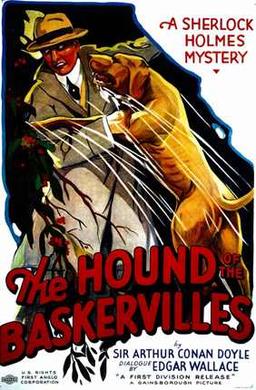
The name that should draw by readers attention on the above poster is not Sir Arthur Conan Doyle, or "Sherlock Holmes", but Edgar Wallace. Wallace was a prolific writer of 957 short stories, 170 novels, 18 stage plays, besides several other screenplays. Gainsborough Pictures had given him the job of turning "The Hound of the Baskervilles" into a screenplay for their film released on December 11, 1931 in Ireland. This was the very first sound version of the story and the sound track was thought lost, but was located in 1991 by the Rank Organization.

Wallace was an excellent choice as anyone familiar with his mysteries would be aware. The feature was released in April 1932 in both England and the United States, but unfortunately Edgar Wallace had passed away on February 10, 1932 at the age of 58. Before his death Wallace brought an original story treatment to American producer Merian C. Cooper. That treatment became the basis for a motion picture released March 2, 1933 in New York City. Edgar Wallace's title was "King Kong".
In the 1931 production "Sherlock Holmes" was portrayed by Robert Rendel, "Dr. Watson" by Frederick Lloyd and "Sir Henry Baskerville" by John Stuart.
This picture is of Watson and "Stapleton", Reginald Bach.
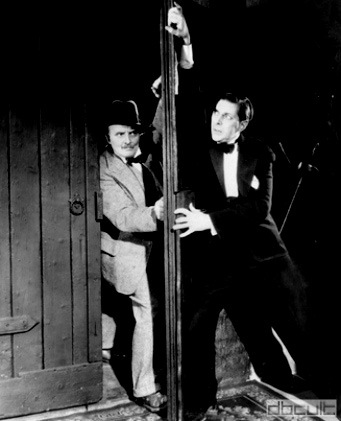
On the following Lobby Card "Stapleton" fights with his wife "Beryl", Heather Angel.
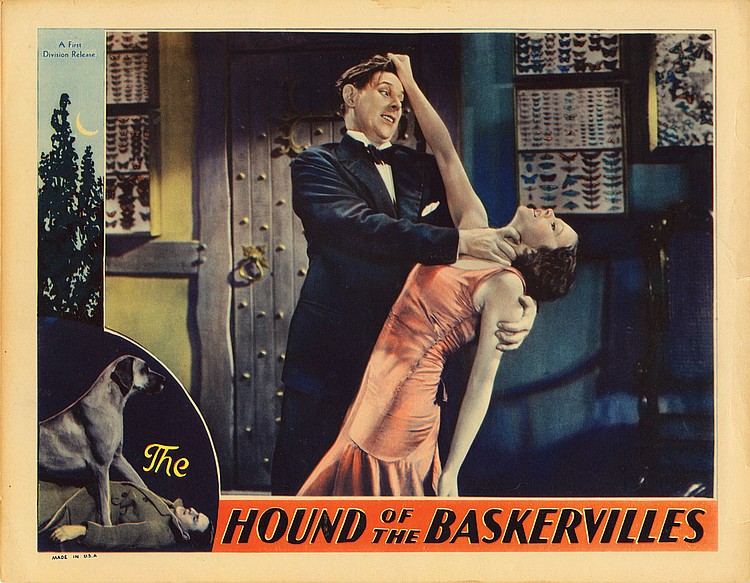
The insert of the hound holding down "Sir Henry Baskerville", lower left on the Lobby Card, is not very frightening. Actually it was shot at a rehearsal to get the actor and dog to know each other.
Gainsborough Pictures' "The Hound of the Baskervilles" wasn't the only "Sherlock Holmes" motion picture playing on U.K. screens in 1931. In February from Twickenham Studios and released by the U.K. Distribution arm of Warner Brothers Pictures was "The Sleeping Cardinal". The film was based upon two of Conan Doyle's stories "The Empty House" and "The Final Problem".
Portraying "Sherlock Homes" was Arthur Wontner and "Dr. Watson" was played by British actor, not "James Bond" writer, Ian Fleming. In the United States the film was known as "Sherlock Holmes' Fatal Hour".
Below Wontner and Fleming from the picture.

That film was the start of a five movie series with the two actors lasting through 1937. It is the 1937 feature that is of importance to this article. All of the five had the names changed for United States audiences. Wontner and Fleming's 5th picture opened in July 1937 as "Silver Blaze" in the U.K., but when it opened four years later in the United States, on January 15, 1941, it had a very interesting title change.

The slim plot has "Sherlock Holmes" taking a vacation, modern day, at the estate of his good friend "Sir Henry Baskerville", Lawrence Grossmith. "Dr Watson" accompanies him, but there is no demonic hound to be found anywhere in this film. Besides "Sir Henry" there is another family member "Diana Baskerville" portrayed by Judy Gunn. As the screenplay is very loosely based upon Conan Doyle's short story "Silver Blaze". We do have a friendly dog so that "Holmes' can get in the quotation about "The dog in the night", but we have no Scotland Yard Detective named Gregory as Conan Doyle wrote it:
Gregory (Scotland Yard detective): “Is there any other point to which you would wish to draw my attention?”
Holmes: “To the curious incident of the dog in the night-time.”
Gregory: “The dog did nothing in the night-time.”
Holmes: “That was the curious incident.”Instead of the missing "Gregory" among the cast of characters were:
"Inspector Lestrade" played by John Turnbull.
"Professor Moriarty" portrayed by Lyn Harding, and
"Colonel Sebastian Moran" played by Arthur Guillet,
Below "Inspector Lestrade".
The plot for the film involves a double murder and the theft of the "Baskerville" race horse "Silver Blaze" by "Professor ROBERT Moriarty". As I mentioned above the actual first name for "Moriarty" is "JAMES".
Oh, the reason for the United States title change was a little bit of publicity awareness caused by the overwhelming popularity in the country of the next motion picture I want to mention. Another small point is that the U.K. print of "Silver Blaze" ran 71 minutes in length, but the American print of "Murder at the Baskervilles" is six minutes shorter at 65 minutes in length.
Released March 31, 1939 was an American Production from 20th Century Fox Studios that is still considered one of the best of the filmed versions of Conan Doyle's Tale. It was also the first of the fourteen pairings of Basil Rathbone as "Sherlock Holmes" and Nigel Bruce as "Dr. Watson".
Before I discuss the actual film I want to quote Rathbone from his 1961 autobiography "In and Out of Character" pertaining to the role and his own popularity. According to the actor:
had I made but the one Holmes picture, my first, The Hound of the Baskervilles, I should probably not be as well known as I am today. But within myself, as an artist, I should have been well content. Of all the 'adventures' The Hound is my favorite story, and it was in this picture that I had the stimulating experience of creating, within my own limited framework, a character that has intrigued me as much as any I have ever played.In 1935 Merian C. Cooper released his motion picture version of H. Rider Haggard's novel "SHE". In this picture Nigel Bruce portrayed "Horace Holly" the companion of Randolph Scott's "Leo Vincey". Watch this movie, from four years before "The Hound of the Baskervilles", and you'll realize, as I have, that Bruce's "Dr. John H. Watson" is the same character he portrayed in "SHE" as "Horace Holly".
The opening of 20th Century Fox's "The Hound of the Baskervilles" has "Sir Charles", Ian Maclaren, being chased from Bakserville Hall by an unseen something. Next the audience hears a dog howling and "Sir Charles" falls dead. The picture cuts to the coroner's inquest with all the main supporting characters in place They consist of "Dr, Mortimer", Lionel Atwill, his wife "Jennifer", Beryl Mercer, "Mr, Frankland", Barlowe Borland, "John (Jack) Stapleton", Morton Lowery, "Beryl Stapleton", Wendy Barrie, and in one of several changes to the story John Carradine portrays the Butler "Barryman" instead of "Barrymore" with Elly Malyon as his wife "Mrs. Barryman".
The next sequence introduces the audience to "Sherlock Holmes", Basil Rathbone, "Dr. Watson", Nigel Bruce, and "Mrs. Hudson", Mary Gordon. Miss Gordon would portray the role in the two 20th Century Fox films and the Universal Studios series as seen below.
"Mrs. Hudson" tells "Holmes" and "Watson" about a visitor. She hands them the cane he absentmindedly left on an end table. This leads directly to Sir Arthur Conan Doyle's sequence, in the novel, about the two deducing who their visitor is and what both the dedication plaque and teeth marks mean on the cane.
"Dr. Mortimer" arrives and tells the history of "Sir Hugo", Ralph Forbes, and "The Hound of the Baskervilles". He adds that Canadian born "Henry Baskerville", portrayed by 21 year old Richard Greene 16 years before he became television's "Robin Hood" for six years, is arriving and the doctor fears for his life.
The above is followed by the audience being introduced to "Sir Henry Baskerville". Who talks about a shoe being taken from his hotel room.

As I mentioned, for those unfamiliar with the story, "Sherlock Holmes" makes up an excuse to appear to remain in London and sends "Dr. Watson" with "Sir Henry" to his new estate. Here the screenplay, by Ernest Pascal, cuts the story to its bare bones so to speak.
"Sir Henry" and "Watson" meet both "Jack Stapleton" and his step sister "Beryl Stapleton". The relationship of the two changes in many of the upcoming versions. In Conan Doyle's original story they are actually husband and wife. The reason here is this was 1930's Hollywood and the story required a somewhat "Happy Ending".
The romance between "Beryl" and "Sir Henry" happens in just two sequences/ As "Watson" comes upon the two in the second. He is informed by "Sir Henry" that they are now engaged to be married.

Earlier in a quick sequence "Sir Henry" and "Watson" see "Barryman" at the window with a candle.
They spot another light and go and investigate. There a man throws a rock at them and runs away. We have no backstory to explain who he is and in the screenplay the role is only identified as a "Convict", Nigel de Brulier.

Another sequence has "Mrs. Mortimer", a Spiritualist Medium, conducts a seance to reach "Sir Charles", but it is interrupted by the howling of the hound. For those who do not know the details of the life of "Sir Arthur Conan Doyle". He had a deep belief in Spiritualism and incorporating that into this tale and some other works was his way of spreading the word that "Spirits" and "Ghosts" do exist.
It wouldn't be until 1916, five years after "The Hound of the Baskervilles" first appeared in "The Strand" magazine that he would reveal this fact. During the 1920's Conan Doyle would get into a war of words with Escape Artist and Illusionist Harry Houdini over the issue. After his mother's death Houdini attempted to reach her through Mediums and then started to debunk them. I have an autographed copy of one of Conan Doyle's books on Spiritualism.
After the incident with the convict. "Watson" and "Sir Henry" meet a strange beggar on "Grimpen Mire".
The beggar turns out to be "Holmes" and as he and "Watson" are talking after this reveal. The howling of the hound is heard and they go to investigate. The two next see the hound push somebody off a cliff in an attack and discover the body of the convict wearing "Sir Henry's" clothing.

At this point "Jack Stapleton" appears to offer assistance. He leaves after "Holmes" says he's not needed. Now the screenplay moves even faster. We quickly learn the convict was "Mrs. Barryman's
brother. "Sherlock Holmes" notices a portrait of "Sir Hugo". He tells "Sir Henry" that everything is safe now that the convict is dead. He and "Watson" leave by train. On the train "Holmes" tells the other he needed to leave to permit the real killer to reveal himself/ At the first train station the two will taken another one and return to catch the killer. Putting "Sir Henry" in danger was the only way "Holmes" could get the proof needed to arrest the man.
The following poster shows the hound as a devilish looking beast.
In the 1939 version of the story the hound is played by a Great Dane.


"Sir Henry" is attacked by the hound after a diner party at the "Stapleton's". "Holmes" and "Watson" arrive to shoot and kill the "Baskerville Hound". "Watson" is told to take "Sir Henry" home and treat his wounds. "Holmes" goes to investigate and discovers were someone has been keeping the animal. While inside the hound's lair somebody closes the trap door and locks the detective inside.

He starts using a pocket knife on the trap door. While back at "Baskerville Hall" "Jack Stapleton" enters to tell "Watson" that "Holmes" needs him to go to the spot they found "Sir Henry". The doctor leaves and "Stapleton" attempts to poison the heir. After putting something in a class of water, but "Holmes" walks in and deliberately causes the glass to spill its contents.
"Stapelton" knows "Sherlock Holmes" has figured out he's the killer. Using a gun to threaten everyone, escapes the room, only to bump into the returning and confused "Dr. Watson", but keeps moving toward the "Grimpen Mire". "Holmes" comes out of the house and blows a police whistle, telling his friend and companion that there are police all over awaiting his signal. There is no doubt "Jack Stapleton" will be caught.
"Jack Stapleton" is actually a member of a branch of the "Baskerville" family and if "Sir Charles" and "Sir Henry" were killed by the legendary hound. "Jack Stapleton" could now reveal his relationship and claim the Estate and title.
Showing the group the portrait of "Sir Hugo". "Holmes" places his hand above and below the eyes and everyone sees the resemblance to the "Baskerville" family.
With everything settled, "Sir Henry" is free to marry the non-related "Beryl Stapleton", the step sister angle used to set up the "Hollywood Happy Ending", and honeymoon in Canada.
After the above climatic sequence, Basil Rathone's "Sherlock Holmes" starts to exit the room and gives the film's closing line:
With everything settled, "Sir Henry" is free to marry the non-related "Beryl Stapleton", the step sister angle used to set up the "Hollywood Happy Ending", and honeymoon in Canada.
After the above climatic sequence, Basil Rathone's "Sherlock Holmes" starts to exit the room and gives the film's closing line:
Oh Watson, the NeedleThis was a sly way of screenplay writer Ernst Pascal, getting around the 1934 motion picture production code, and slipping in a reference to Sir Arthur Conan Doyle's "Sherlock Holmes'" use of a SEVEN PERCENT SOLUTION OF COCAINE as a means of "relaxing".
At the time of this writing there is a pristine print of the motion picture available on line for free viewing.
The motion picture is considered a "Classic" by many and there may be two major reasons for that statement. The first is very obvious. As I have already mentioned "The Hound of the Baskervilles" was the first time Basil Rathbone and Nigel Bruce appeared as "Sherlock Holmes" and "Dr. Watson.
Six months later, on September 1, 1939, 20th Century Fox released the dual in "The Adventures of Sherlock Holmes". The last period piece they would appear in.
During the next twenty years the 1939 picture was the only English language version of "The Hound of the Baskervilles" made before 1959. Which it must be considered added to the film's mystique. The feature wouldn't be seen on television until the early 1960's after the rights to the film ran out and were not renewed. It would be even longer for "The Adventures of Sherlock Holmes" to be seen on television.
The only other "Sherlock Holmes" motion pictures released during that 20 year period, 1939 to 1959, were the Rathbone/Bruce series from Universal Studios. These 60 minute or so films, 1942 to 1946, were set in the year they were made. As a result even with "Professor Moriarty", or "Sebastian Moran" the settings were World War 2. As "Holmes" and "Watson" battled the Axis powers. During the 1950's and early 1960's that series was shown multiple times in syndication on television.
In fact, there was only one non-Rathbone/Bruce motion picture made prior to 1959 and that was a Foreign film.
I have no photos, but only a story line for a 1951 adaption of "The Hound of the Baskervilles" set in India and made by a Bengali production company in that language entitled "Jighansa". Actually "Holmes" and "Watson" do not appear in the film. Screenplay writers Manoranjan Ghosh and Hiren Nag took the basic Conan Doyle story and moved it to India. I am not sure if there was a dog in the film, but the plot starts with the murder of "King Chandrakanta" and a "Dr. Palit", Kamal Mitra, is asked for help from his friend "Detective Smarajit Sen", Shisir Batabyal, in protecting the heir to the crown. A poor landowner "Mr. Gupta", Bikradh Roy, and a young women "Manjusri", Manju De, are seeking revenge on the new heir so they can claim the throne. Sounds pretty much like the story.
Also prior to 1955 there were five television programs, but four were only one time live productions.
The first was on the American Television series"Your Show Time" and was "The Adventure of the Speckled Band" starring Alan Napier as "Holmes". Napier portrayed the Butler "Alfred" on the 1960's camp television show "Batman". Melville Cooper was Napier's "Dr. Watson", The program aired live on March 25, 1949.
The second was a British short entitled "The Man Who Disappeared". It was an unsold 1951 pilot for a "Sherlock Holmes" TV series in the U.K. The pilot starred John Longden as "Sherlock Holmes" and Campbell Singer as "Dr. Watson".
Below John Longden as "Holmes".

The third was on the CBS Drama Anthology series "Suspense" and was entitled "The Adventure of the Black Baronet" written by Arthur Conan Doyle's youngest son Adrian. The production starred Basil Rathbone once again as "Sherlock Holmes" and Martyn Green as "Watson". The live performance was on May 26, 1953.
From October 18, 1954 through October 17, 1955 there was a syndicate series "Sherlock Holmes" starring Ronald Howard. He was the son of 1930's and 1940's actor Leslie Howard who portrayed "Ashley Wilkes" in "Gone with the Wind" among other roles. Portraying "Dr. Watson" was Marian Crawford. Of the 39 episodes only four were even related to original works by Sir Arthur Conan Doyle.
The fourth production was a West German television version of "Der Hund von Baskervilles". Wolf Ackva was "Sherlock Holmes" and Arnuff Schroder was "Dr. Watson". The live broadcast ran 80 minutes in length and at the last minute somebody provided a German Shepherd to be the Hound. Which wasn't a problem with German viewers, because in English the story translated, in Germany, as "The Dog of the Baskervilles". That title translation went back to the first appearance of Sir Arthur Conan Doyle's original novel in Germany. Most Germans hadn't any idea of what a "British Hound" looked like. However, a large dog worked for the publishers and their readers.
In 1957 the British movie studio Hammer Films released "The Curse of Frankenstein". The first version of Mary Shelley's tale in Bloody Technicolor. It paired actors Peter Cushing as "Dr. Frankenstein" and Christopher Lee as the "Creature". In 1958 they two were teamed up in Hammer's version of Bram Stokers "Dracula". The title in the U.K., but known in the United States as "Horror of Dracula". The film was filled with Technicolor blood dripping from vampire fangs. Lee portrayed the "Count" and Cushing was "Van Helsing. The two would be re-teamed in May 1959 with the U.K. release of Sir Arthur Conan Doyle's "The Hound of the Baskervilles". Peter Cushing was "Sherlock Holmes", but Christopher Lee wasn't "Dr. Watson". He portrayed "Sir Henry Baskerville" and Andre Morell was cast as "Watson".
The screenplay by Peter Bryan went to the Horror of Sir Arthur Conan Doyle's story that all previous versions had not centered upon. The posters for the film reflected this in the images of "The Hound of the Baskerville" itself. While the film was promoted as a Gothic Horror movie and not a mystery.

The motion picture opens with "Dr. Motrtimer", Francis de Wolff, narrating the story of "Sir Hugo", David Oxley. This sequence runs a full 8 minutes in length, at the appropriate moments the music, some taken from Hammer's "Dracula", increases the tension and terror.
The sequence opens with a man pleading for his daughter as "Sir Hugo" forces him into a fireplace and his death. As "Sir Hugo's" male guests watch and in some cases cheer him on.

During the above scene there are cuts to the girl in her locked room. "Sir Hugo" makes a wager about the girl and then go up a staircase to get her. He is followed by his guests, but she is gone and this maddens him.
"Sir Hugo" lets loose his hounds and goes after the girl following her onto the Grimpen Mire. The frightened girl is caught at some possibly Druid ruins by "Sir Hugo" Where he takes a knife and murders her.
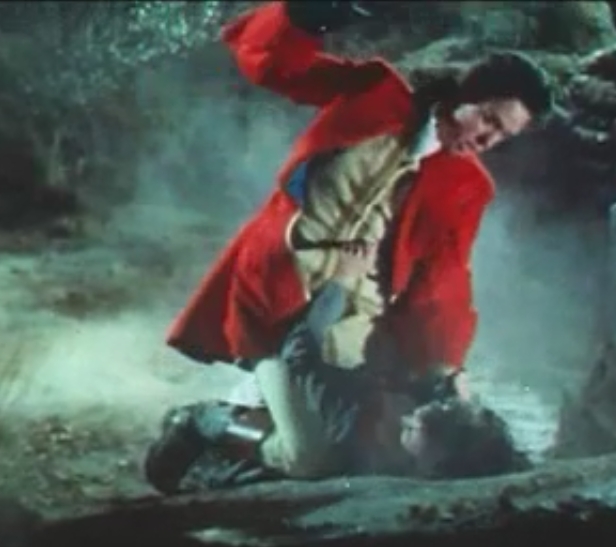
The color is obviously off in the following shot.

Suddenly their is the howl of a hound and "Sir Hugo" looks up and sees something that attacks him. The knife he was holding, covered in Technicolor blood, is seen tossed away letting the audience know he has been killed by the hound.

Cut to "Dr. Mortimer", "Holmes", Peter Cushing, "Dr. Watson", Andre Morell, in the sitting room of 221-B Baker Street. As the doctor finishes his story reading the line:
The Hound of Hell! The Hound of the Baskervilles!
This opening is extremely effective and sets the mood for the audience.

After some questions from "Holmes" to "Dr. Mortimer" to permit the detective to obtain the true facts about the death of "Sir Charles". That includes one addition to the story and that is that "Sir Charles" died on Friday, the 13th. A throw away line that adds to the Gothic Horror theme though. A change to the story comes when it is revealed "Sir Henry" is coming from his home in Johannesburg, South Africa and not Toronto, Canada as in the novel and the 1939 production.
"Holmes" agrees to meet "Sir Henry" the next day at his hotel. There we have dialogue about "Sir Henry's" missing shoe and another horror element added to the screenplay not in the original novel. While holding his other shoe a tarantula comes out of it and up "Sir Henry's" sleeve. This is important as the audience already knows, from "Dr. Mortimer", also not in the novel, that the "Baskervilles" have an hereditary weak heart.
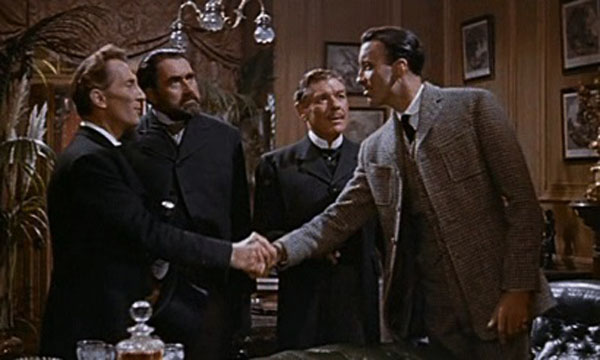

After killing the tarantula the scene leads to "Holmes" saying he has to finish work in London, but that "Dr. Watson" will accompany "Sir Henry" to "Baskerville Hall". On the way there "Watson", "Sir Henry" and "Dr. Moritmer" are told of an escaped convict named "Seldon", Michael Mulcaster, now somewhere on the Grimpen Mire. Arriving at the Hall "Watson" and "Sir Henry" are introduced to "Barrymore", John le Mesurier, the family retainer.
As the two are lead to their rooms they notice that one of two portraits of "Sir Hugo" is missing and "Barrymore" states it was stolen several months ago. On a walk "Dr. Watson" meets "Stapleton", Ewen Solon. Just before he was about to step on an animal trap set by the other man. "Stapleton" explains he must catch animals this way as his Right Hand has Webbed Fingers. A point not in the actual Conan Doyle story.
"Stapleton" leaves and "Watson" starts to walk along the road by the Grimpen Mire. After being warned not to go off the road for his safety. As the doctor is enjoying his walk he sees a girl sitting beside the road. She will turn out to be "Stapelton's Daughter Cecile", Marla Landi. A name change from "Beryl".

After seeing "Watson" the girl starts to run away and he gives chase getting himself caught in the mire. "Stapelton" appears and tells "Cecile" to help him get the doctor out. She immediately appears confused by her father's words, but helps. It is then that she finds out he is not "Sir Henry". The three return to Baskerville Hall in a cart driven by her father.
"Watson" and "Stapleton" enter the hall, but "Cecile" is told to remain with the cart. Shortly "Sir Henry" appears on a horse and introduces himself. The girl runs off and "Sir Henry" naturally follows and catches up with her. "Cecile" impulsively kisses him, or it seems as such, and then goes back to the cart to leave with her father. After "Stapleton" introduces himself to "Sir Henry".
It is evening and "Sir Henry" hears a noise and goes to investigate. He is about to open a closed door with a light coming from under it. When "Watson" appears and the two enter to find the room empty, but a candle burning on a window-seal. They look out the window and notice another far off light. The two leave Baskerville Hall for the mire to investigate.
As they walk toward were the light is still located. A strange man runs past them and the howling of the hound is heard. "Sir Henry" has a minor tension attack on his heart and "Watson" helps him back to the Hall, but before this. He notices a man silhouetted in the distance.
Cut to "Watson' and "Dr. Mortimer" exiting "Sir Henry's" room. The other doctor was called for a second opinion. "Watson" wants to leave "Sir Henry" in "Mortimer's" care as he goes in search of the silhouetted man.
He turns out to be "Holmes" and then as the two are talking the howl of the hound is heard. They run towards it, but see a man attacked and killed. When the two reach the body it is lying face down and from the clothing "Holmes" deduces that "Sir Henry" has been killed. He tosses his coat over the body and says he'll arrange for it to be picked up in the morning. Returning to the Hall they are surprised to find "Sir Henry" there and "Holmes", to himself, realizes the hound has killed "Seldon".
As "Watson" takes the detective up to a room for the night. They stop at the portrait of "Sir Hugo" and "Holmes" asks about the missing picture. The Detective makes a comment that implies he expected it to be gone and then continues up the staircase.
Taking "Barrymore'" with them to get "Seldon's" body the three discover it is missing and has been moved to the Druid ruins were "Sir Hugo" was killed. There they find that the body has been mutilated and beside it the original knife used by "Sir Hugo".

Upon returning to "Baskerville Hall" "Holmes" gets "Barrymore's" wife to reveal herself as the sister of the now dead convict by asking a question to "Miss Seldon".
After meeting "Bishop Frankland", Miles Malleson, "Holmes" finds out about a stolen tarantula. Again a slight change here as the character of "Frankland", he's not a "Bishop", or an entomologist as Conan Doyle wrote him. He is more the character of the 1939 feature.
"Holmes", "Dr. Mortimer and "Stapleton" enter an old mine as "Watson" waits outside, if assistance is needed. The detective is working off a statement "Seldon" made to him about hearing the howling of the hound coming:
From the Depths of Helland has deduced that it is being held underground. As the three work their way deep into the mine shaft. "Holmes" is asked what he's looking for and his reply is bones. Not referring to a human skeleton, but from meat left for the hound. Suddenly a mine cart comes at him taking down the supports and trapping the detective. The screenplay has been giving out the possibility that either "Dr. Mortimer", or "Stapleton" is the killer and this scene gives the audience a further impressions of this idea. Which of course any reader of the novel would known the difference.
After digging to get "Holmes" out of the cave-in. The men give up and returning to their cart find "Sherlock Holmes" sitting there. He explains he would never enter a mine without knowing what escape routes it contained.

Later "Sir Henry" visits the cottage home of the "Stapelton's" and finds "Cecile" there. She reveals herself to be a very angry young women, We learn she was born in Spain and her mother was Spanish. She was forced to come to England by her father. Who wanted to live in his homeland and not hers. Again out of apparent passion for each other the two kiss as "Stapleton" enters. He invites "Sir Henry" and his guests to diner.
In "Holmes" room "Sir Henry" tells both men about the dinner invitation. However, the detective makes an excuse that his injured leg, from the mine, will keep him at the hall and besides "Sir Henry" didn't really want the two of them to come along. This is a dig "Holmes" purposely makes, because he wants to use "Sir Henry" as bait.
After diner "Cecile" takes "Sir Henry" to the ruins and reveals to him that she too is a "Baskerville" and was the one that lured "Sir Charles" to his death.
Then the howl of the hound is heard.
And "The Hound of Hell" appears Hammer style.
"Holmes" and "Watson" come out of hiding and shoot the dog as it attacks "Sir Henry". "Stapleton" attempts to stop them and is shot first by "Dr. Watson" and then mauled to death by the hound. In the novel after being shot by "Watson". "Stapleton" disappears and he is thought to have died in the Grimpen Mire. Which is closer to the ending of the 1939 film version.
"Holmes" attempts to stop "Cecile", but she runs away towards the Grimpen Mire. So he joins "Watson" in attending to "Sir Henry".
Next "Sir Henry" is made to face his fear of "The Hound of the Baskervilles". Which turns out to be a starved dog with a mask made by "Stapleton" to make it look more fearsome.
It should be noted that neither the 1939 version. or this film have the hound looking as written by Conan Doyle, In the novel it is made to look ghost like by covering the dog's body with phosphorous.
As the three head back to the hall they hear screams from "Cecil" as she has fallen into the mire and sinks beneath it.

In the novel "Beryl Stapleton" does not die.
"Holmes" will explain that the reason the painting of "Sir Hugo" had been stolen was that it showed his right hand to be webbed like "Stapleton". Cut to "Sherlock Holmes" and "Dr. Watson" at breakfast back at 221-B. "Sir Henry" has sent "Holmes" the missing portrait of "Sir Hugo" for his famed crime collection. The closing line has nothing to do with a Seven Percent Solution. Instead "Holmes" in reply to "Watson's" inquiry about how he figured the mystery out. Says:
ELEMENTARY DEAR WATSON, ELEMENTARY, HAVE A MUFFIN?For those of my readers who might have liked to have seen Christopher Lee as "Sherlock Holmes". There is a West Germany/France/Italy co-production written by German American writer Curt Siodmak and directed by British director Terrence Fisher. Who directed "Curse of Frankenstein", "Dracula", "Hound of the Baskervilles" and "The Mummy" all with Lee.
This created story by Curt Siodmak is entitled ""Sherlock Homes und das Halsband des Todes (Sherlock Holmes and the Deadly Necklace)". Involving "Professor Moriarty" stealing Cleopatra's necklace.
Before I proceed further I believe a clarification about "Beryl Stapleton" is needed as her name changed so much in the films and completely in 1959.
The following is Sidney Paget's drawing of "Sir Henry" meeting "Beryl".

She was born in Costa Rica as "Beryl Garcia". It was on a visit to that country that "Roger Baskerville III" met her and the two became married. They had to flee Costa Rica after "Roger" embezzled a large sum of money. They first changed their last name to "Vandaleur" and moved to England. There they attempted to open a school, but the venture failed. What happened exactly is not explained, but speaking to "Dr. Watson", at a later date, "Roger" speaks of an epidemic that cost the lives of many school children. What that was, if it actually happened, is not revealed.
After the event with the failed school "Roger" turns to petty crime and robbery for the two to live on. It is at this time that he dreams up the fantastic idea of bringing back the "Hound of the Baskervilles". The two change their last names now to "Stapleton" and his first to "John", known as "Jack", and the events of the novel unfold.
Returning to the motion picture's is a remake of a film that used the concept of Sir Arthur Conan Doyle's novel adapted to their own county of India. This version of "Jighansa" is not in Bengali, but Hindi. Now titled "Bees Saa; Baad (Twenty Years Later)" released in 1962. Once more there is only a hint of the Conan Doyle story. As a man known as a "Thakur", an Indian feudal title of prestige, rapes a young girl who then kills herself. Her spirit twenty years later is taking revenge on the Thakur's grandson. Who had come to the village that the rape occurred and is warned that the spirit of the girl will seek him out. He falls in love with a young women, but the spirit of the dead girl appears near a swamp were the original suicide took place. The alleged spirit turns out to be the Uncle of the raped girl in a disguise. The police detective will arrest him and the two lovers have a happy ending.
.

September 30, 1968 saw the First of a Two Part BBC adaption of "The Hound of the Baskervilles" and Peter Cushing was back as "Sherlock Holmes". Nigel Stock, 1963's "The Great Escape", played "Dr. Watson" in this production. Part Two would be shown on October 7, 1968.
Portraying "Sir Henry" was actor Gary Raymond. He had been seen earlier on the United States motion picture screen, as the future "King of Spain", in the 1961 epic "El Cid" starring Charlton Heston and Sophia Loren and in Ray Harryhausen's 1963 "Jason and the Argonauts". On television in both the UK and the States he was a regular on the World War 2 drama "The Rat Patrol".

Below the "Hound of Hell" for the BBC.
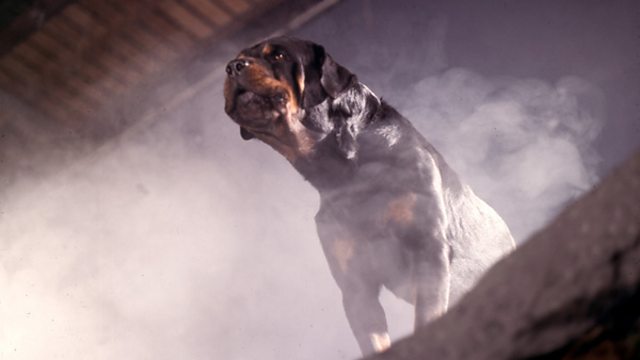
I British review of this television production hit it with both barrels:
This was the second time Peter Cushing had played Sherlock Holmes in an adaptation of The Hound of the Baskervilles, the first being nine years previously for Hammer. They're both great, but unrecognisably different from each other. This is a 1968 BBC TV version and furthermore you'd be able to tell after only thirty seconds.
Firstly, it's too faithful to the text. It's the kind of thing you see in bad, overly stiff adaptations, where the writer's too close to the text and is simply transcribing scenes from the original without a care for whether they need fleshing out. I'm no fan of the romantic side of the Basil Rathbone version, but at least they were doing something with it. Here Sir Henry falls in love with Miss Stapledon without bothering to notify the audience. "You are in love with her." "Perhaps I am." Eh? Did they cut a scene or something? That's merely bad, but downright weird is the scene where Stapledon gets jealous about Sir Henry's affections. Conan Doyle doesn't show us the scene directly, doing it through reported speech, but here they just plonk it in front of us and thus Stapledon treats us to what would seem to be the Oedipal Complex of Scarytown. Wow. No way is she his sister. That's a jealous husband if ever I saw one and it's been made far too obvious.
There are also some bad transitions. They mishandle the introduction of Laura Lyons in episode two, making it look like a plot lurch rather than the normal progress of a detective story.
Secondly, it's practically a stage play. It looks, feels and moves like a standard prestige production of the time, until we get to the action. Wow, that was bad. The sequence with Stapledon's carriage in London is so shocking as to almost worth watching just for that. I presume they couldn't afford any extras and filmed in a public park at something like six in the morning, so you have Holmes and Watson following someone and looking as inconspicuous as they can on this completely empty road. "I've failed," decides Holmes and steps into the open, when the person he's seeking is about to appear. Could any detective be made to look more incompetent? A lone horse and carriage comes clip-clopping along this still-deserted road and... oh, words fail me.
That's merely rubbish, but the finale is actually damaging. Day-for-night filming to make Hammer's look convincing. The hound savages Sir Henry for so long that he should have been dead ten times over. It's a fairly lame-looking dog, too. Then we see Stapledon disappear under the swamp with his mouth open (eugh) and... the closing credits? I can't remember ever seeing such an abrupt ending. It's tempting to blame the medium and the era, but personally I think we've got to say that the director was a deaf-blind retard.
However all things considered, I'd say that staginess is not only a good thing but the production's biggest selling point. This is the kind of adaptation that would spend 13 fifty-minute episodes on a Dickens novel without even embroidering on the text. It's all about the dialogue. Scenes are allowed to play out as they would on the stage, with the main difference being that the camera is delighted to get close to the actors. No modern TV production would dare shoot something so uncinematic, but the results are absorbing. It's all about the performers, who get all the room you could ask for to luxuriate in their roles.The entire review can be found at:
http://finnclark.thiswaydown.org/Review/TheHoundoftheBaskervilles(1968).html
On November 15, 1968 was Part One of an Italian television production entitled "L'Ultimo dei Baskerville (The Last of the Baskerville)". Part Two was on November 22, 1968 and the final episode on November 29, 1968.
Portraying "Sherlock Holmes" was Nando Gazzolo.

Portraying "Dr. Watson" was Gianni Bonagura.
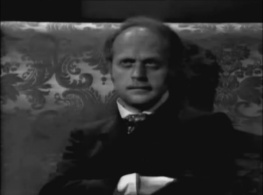
Paolo Carlini was "Sir Henry".
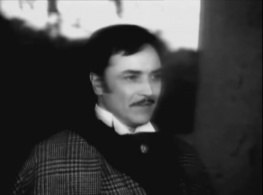
Franco Scandurra was "John Stapleton"
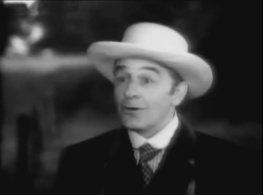
Marina Malfitti was "Beryl Stapleton"
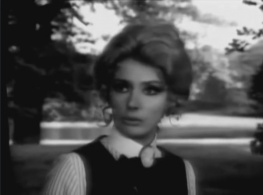
Other than referring to the "Hound" specifically as a "Mastiff". The story appears to be a remake of the 1939 production. Also leaving out the secondary character of "Laura Lyons".
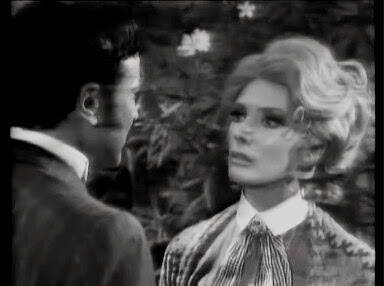
I could not locate any stills or a plot for the 1971 Soviet Union television production of "Sobaka Baskerviley" or the "Hound of the Baskervilles".
The cast included Nickolay Volkov, Jr. as "Sherlock Holmes", Lev Krugly as "Dt. Watson", Oleg Shklovsky as "Sir Henry" and Ekaterina Gradova as "Beryl Stapleton".
A 74 minute made for ABC television version appeared on February 12, 1972 starring Stewart Granger as "Homes" and Bernard Fox as "Watson".
The production was terrible even with an excellent cast. The screenplay changed names and attempted too many characters.. One of the most interesting, but problematic casting choices was William Shatner as both "Sir Hugo" and now "GEORGE Stapleton".
Even if you where unfamiliar with the idea of "Stapelton" being related to the Baskerville family. Look at this photo of Shatner as "Sir Hugo", if you knew the actor you knew the face. Let alone the voice.

Below Shatner as "George Stapleton".
Ian Ireland was "Sir Henry", Anthony Zerbe was "Dr. Mortimer" and Jane Merror was "Beryl Stapleton"
Sally Ann Howes was "Larua Frankland" changing "Laura Lyons" into the daughter of now "Arthur Frankland" played by John Williams.
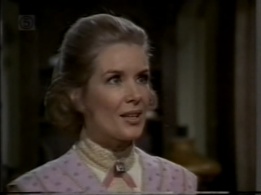
If the Universal Studios television production was bad. The 1978 comedy made from Sir Arthur Conan Doyle's novel was worse. The idea of turning "The Hound of the Baskervilles" into a comedy looked good to British comedians Peter Cook and Dudley Moore. They hired director/screenplay writer Paul Morrissey to work with them. The result, even with Terry-Thomas in his last screen appearance, was a mess and the audiences reacted negatively to the film. Although admittedly there were some funny moments.
Three years earlier comedian Gene Wilder had success with his comedy "The Adventure of Sherlock Holmes' Smarter Brother". The brother was not "Mycroft", but the unknown "Sigerson" portrayed by Wilder. That film had a 1975 budget of $2,805,000 and made over $20 million dollars at the box office. So the idea of turning "Conan Doyle" to comedy had been proven previously. It was just a case of execution.


The next screen treatment returned to the serious and came out of Soviet Russia in 1981. This two part Russian television version runs approximately 147 minutes. The English language title is:
"The Adventures of Sherlock Holmes and Doctor Watson: The Hound of the Baskervilles". The production was part of a series of Conan Doyle stories.
There are a few changes to the plot. When "Watson" and "Sir Henry" confront "Barrymore" at the window with the candle. He admits that the escaped convict "Seldon" is the brother of his wife. The "Stapleton's" are a married couple and introduced as such. After discovering the resemblance between "Sir Hugo" and "Stapleton" through the portrait. "Holmes", "Watson" and "Inspector Lestrade" wait outside of the "Stapleton Cottage" where "Sir Henry" is dinning. "Sir Henry" leaves and the hound attacks. "Lestrade" kills it and "Stapleton" escapes into Grimpen Mire where he dies.

The Soviet Union who believed their Communist system was better than the British way of life. Did not pass up the opportunity of inserting many stereo types and overblown British customs into the production.
He had been "Rasputin" in the epic 1971 motion picture "Nicholas and Alexandra". He was an evil magician in Ray Harryhausen's 1973 "The Golden Voyage of Sinbad" and of course the "Fourth Dr. Who" from December 28, 1974 through March 21, 1981. So Tom Baker was an obvious choice to portray "Sherlock Holmes" in a BBC four part serial of "The Hound of the Baskervilles" premiering October 3, 1982.
Below Tom Baker as "Holmes" and Terence Rigby as "Watson".

Sally Ann Howes was "Larua Frankland" changing "Laura Lyons" into the daughter of now "Arthur Frankland" played by John Williams.

If the Universal Studios television production was bad. The 1978 comedy made from Sir Arthur Conan Doyle's novel was worse. The idea of turning "The Hound of the Baskervilles" into a comedy looked good to British comedians Peter Cook and Dudley Moore. They hired director/screenplay writer Paul Morrissey to work with them. The result, even with Terry-Thomas in his last screen appearance, was a mess and the audiences reacted negatively to the film. Although admittedly there were some funny moments.
Three years earlier comedian Gene Wilder had success with his comedy "The Adventure of Sherlock Holmes' Smarter Brother". The brother was not "Mycroft", but the unknown "Sigerson" portrayed by Wilder. That film had a 1975 budget of $2,805,000 and made over $20 million dollars at the box office. So the idea of turning "Conan Doyle" to comedy had been proven previously. It was just a case of execution.


The next screen treatment returned to the serious and came out of Soviet Russia in 1981. This two part Russian television version runs approximately 147 minutes. The English language title is:
"The Adventures of Sherlock Holmes and Doctor Watson: The Hound of the Baskervilles". The production was part of a series of Conan Doyle stories.
There are a few changes to the plot. When "Watson" and "Sir Henry" confront "Barrymore" at the window with the candle. He admits that the escaped convict "Seldon" is the brother of his wife. The "Stapleton's" are a married couple and introduced as such. After discovering the resemblance between "Sir Hugo" and "Stapleton" through the portrait. "Holmes", "Watson" and "Inspector Lestrade" wait outside of the "Stapleton Cottage" where "Sir Henry" is dinning. "Sir Henry" leaves and the hound attacks. "Lestrade" kills it and "Stapleton" escapes into Grimpen Mire where he dies.
The Soviet Union who believed their Communist system was better than the British way of life. Did not pass up the opportunity of inserting many stereo types and overblown British customs into the production.
He had been "Rasputin" in the epic 1971 motion picture "Nicholas and Alexandra". He was an evil magician in Ray Harryhausen's 1973 "The Golden Voyage of Sinbad" and of course the "Fourth Dr. Who" from December 28, 1974 through March 21, 1981. So Tom Baker was an obvious choice to portray "Sherlock Holmes" in a BBC four part serial of "The Hound of the Baskervilles" premiering October 3, 1982.
Below Tom Baker as "Holmes" and Terence Rigby as "Watson".

All of the characters from the novel are present, but one has to wonder about the BBC doing the story. Back in 1968 it had mixed reviews with Peter Cushing doing "The Hound of the Baskervilles" and this happened a second time with this production. In a review of what "The Daily Telegraph" considered the Top 20 actors to portray "Sherlock Holmes" Tom Baker was Number 15 they wrote that he:
So was the "Hound of Hell" becoming a tiresome "TAIL" to wag? Apparently not as the American Cable Network HBO got into the act on November 3, 1983. The film was from Executive Producer Sy Weintraub. Who had made nothing but "Tarzan" pictures in the United States. Let's see there were the two Gordon Scott films 1959's "Tarzan's Great Adventure", with an unknown Sean Connery as a bad guy, and 1960's "Tarzan the Magnificent".. Then he switched to actor Jock Mahoney for 1962's "Tarzan Goes to India" and 1963's "Tarzan's Three Challenges". Can't forget the 67 episode television series and my reader gets the picture. Somehow he wanted to make a "Sherlock Holmes" series, but as actor Ian Richardson, "Sherlock Holmes", told the "Scarlet Street" magazine. Weintraub ran into copyright issues and Jeremy Brent:
Below Denholm Elliott as "Dr. Mortimer". The actor is probably best known for his role in the "Indiana Jones" movie series.


Above Glynis Barber as "Beryl Stapleton"
Below she's with Martin Shaw as "Sir Henry"

With a lot more effectiveness than William Shatner. Nicholas Clay played both "Sir Hugo" and "Jack Stapleton".

Over all this was an excellent film, but like the others had some differences to the novel. In the opening sequence of the novel the farm girl kidnapped by "Sir Hugo" escapes and dies from fatigue. Not very cinematic and why every version goes to lengths to portray "Sir Hugo's" evil side. In this screenplay she escapes on a horse, but the horse gets trapped in the Grimpen Mire. "Sir Hugo" finds her and rapes the girl. She then witnesses the hound kill him and starts the legend herself.
In several of the earlier films including the dueling "Classics" from 1939 and 1959. Scotland Yard Inspector "Lestrade" is no where to be seen. This screenplay adds one element to the fact that he, like other Scotland Yard detectives, has been after "Seldon" since his escape. Here the audience is told "Inspector Lestrade" was also "Seldon's" original arresting officer.
In this screenplay "Laura Lyons" now has a husband "Geoffrey". A character that never appears in the original novel. He becomes the main suspect in the murder of "Sir Charles", but is proven innocent by "Sherlock Holmes". However, his wife, "Laura Lyons", is murdered by the real killer as she has discovered his identity. "Miss Lyons" does not die in the novel, or previous versions of "The Hound of the Baskervilles" that she actually appears in.
This version has "Stapleton" fleeing into the Grimpen Mire and as he starts to sink. "Sherlock Holmes" attempts to save his life, but to no avail.
Also in 1983 Australia released "Sherlock Holmes and the Baskerville Curse" an animated, but accurate version of the Conan Doyle novel. Voicing "Holmes" was Peter O'Toole.

Voice actor Earle Cross was "Dr. Watson". This was part of a series of four animated films that the two actors voiced. Which included "A Study in Scarlet", "The Valley of Fear" and "The Sign of the Four".
On April 24, 1984 Sy Weintraub was caught up in his own "Sherlock Holmes" curse as ITV-Granada started their series with Jeremy Brett as "Sherlock Holmes". "The Hound of the Baskervilles" was broadcast on August 31, 1988. Portraying "Dr. Watson" in the series was Edward Hardwicke.


Portraying "Sir Henry Baskerville" was actor Christopher Tabori

Tabori was born Christopher Donald Siegel. He is the son of American director Don Siegel, 1956's "Invasion of the Body Snatchers" and 1962's "Hell is for Heroes", and Swedish actress Viveca Landfors.
Alastair Duncan, at the time Neil Duncan, was "Dr. Mortimer". His voice acting would become a regular in many animated series. Several of the "Batman's" have him as "Alfred". He also voices parts in "Star Wars" and "Middle Earth" video games.
Below Fiona Gillies as "Beryl Stapleton".

At last somebody got the "Hound" right.


The website "DVDLog" had this to say about this production:
On October 16, 1995 the Public Broadcasting System (PBS) children's television series "Wishbone" did an adaptation of "The Hound of the Baskervilles".

A stray dog in the neighborhood is causing trouble and "Wishbone" is getting the blame. As the dog is tracked down our hero is reminded of the Sir Arthur Conan Doyle story.
Four years later was another animated version of the "Hound" in the series "Sherlock Holmes in the 22nd Century".Created by Scottish television this series reworks Sir Arthur Conan Doyle's adventures into a futuristic setting.
The series began with "New Scotland Yard Inspector Beth Lestrade" being up against a clone of "Professor James Moriarty".To battle "Moriarty" she takes the preserved body of "Sherlock Holmes", located in the basement of New Scotland Yard in a glass case, to a scientist, who looks like Conan Doyle, to rejuvenate it. The great detective is back.
Below the 22nd Century "Professor James Moriarty"

Apparently three visitors to the Moon are attacked by a Phantom Hound of the Baskervilles and it is up to "Sherlock Holmes' to solve the mystery behind it. This wasn't one of the stories that actually followed Sir Arthur Conan Doyle in this futuristic setting, but "The Empty House", "The Speckled Band" and "The Red Headed League" stay very close to the originals.
Now enters Canada with my favorite version of the story. Although Canadian the picture appeared first on United States television October 21, 2000 and seven days later on Canadian.
Portraying "Sherlock Holmes" was Matt Frewer. In 1985 he was both Edison Carter and his computer generated counter part in the motion picture "Max Headroom". Late Frewer repeated the role on two television series between 1986-1988. He also provided voices for the Walt Disney Company in "Gargoyles" and other shows. Nine years after making the "The Hound of the Baskervilles" he was "Moloch" in the movie "Watchmen" Kenneth Welsh was "Dr. Watson".

Jason London was "Sir Henry". London had portrayed "Pink" in 1993's "Dazed and Confused" and in the same year as this production. He would portray the Greek Hero "Jason", great name choice, in the television mini-series of "Jason and the Argonauts".

Emma Campbell portrayed "Beryl Stapleton" and Robin Wilcock was "Stapleton"

"Dr. Mortimer" was portrayed by Gordon Masten
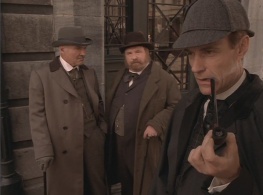
In it's solid 90 minute running time Joe Wissenfeld's screenplay attempts to tell the complete novel and is filled with many horror elements. Especially the look of the hound that appears unexpectedly in some scenes. Such as a Christmas party at the window.

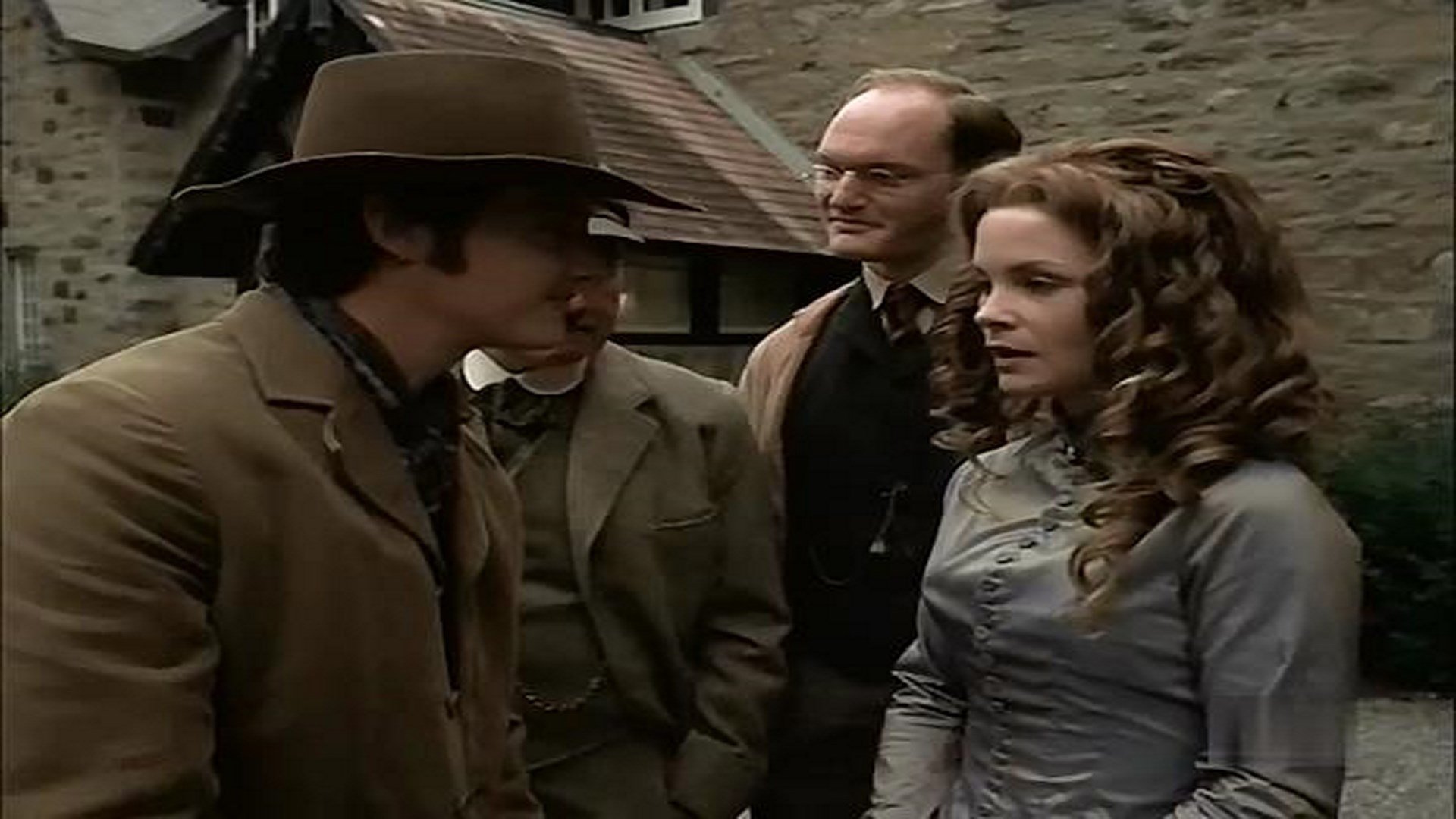
The picture gets overlooked as originally it first appeared in the United States on the Hallmark Channel and not one of the major cable movie channels. My opening picture of "Baskerville Hall" is from this production.
Two years later, on November 18, 2002, Canadian television released another version of "The Hound of the Baskervilles" actually made in the U.K. Where it would not appear until the following month on December 26th and finally on United States television January 19, 2003.
This time the two roles of "Sherlock Holmes" and "Dr. Watson" were portrayed by Richard Roxburgh and Ian Hart respectively.
This version of Conan Doyle's novel had an unique scene after the hound is killed with Ian Hart of the left of it and Richard Roxburgh on the dead dog's right. Not the almost Bat like features to the Hound.
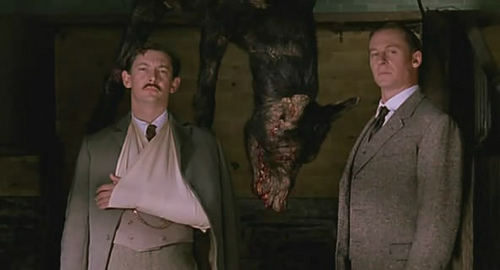
Richard E. Grant was "Jack Stapleton" and Neve McIntoch was "Beryl Stapleton" and Matt Day was "Sir Henry". While John Nettles was "Dr. Mortimer" and Danny Webb was "Inspector Lestrade"
This version like Hammer's 1959 motion picture has "Sherlockians" with more extreme views upon how the story was presented and the look of the "Hound", itself, is often debated.
In the year the film came out Richard Scheib for the British "Moria-The Science Fiction , Horror, and Fantasy Review" wrote that this film was:
The controversy over the 2002 film does stem from 19 major differences within the screenplay as compared to the original novel.
These differences include a major change to the legend of "Sir Hugo". In this version he is married and believes his wife is having an affair with their neighbor. He beats her and she runs away from Baskerville Hall toward Grimpen Mire. "Sir Hugo" pursues, but her own hound pursues both of them. "Sir Hugo" kills his actually faithful wife and her hound kills him while being fatally stabbed. According to this legend the "Ghost of the Wife's Hound" haunts Baskerville Hall.
Another change, which actually goes back to the 1939 Basil Rathbone/Nigel Bruce production concerns "Dr. Mortimer's wife". Once again she is shown as a "Spiritualist Medium" who holds a seance. However, no such character appears in the original novel.
A third example contains "Roger Stapleton's" background that I mentioned speaking of 'Beryl's". In this production he was a member of the "Queen's Guards" and was drummed out of the service for Conduct Unbecoming a Officer.

It would be another twelve years before "The Hound" returned and this was in the second season, second episode of the modern version of "Sherlock Holmes". Found on the BBC series simply called "Sherlock", January 8, 2012.
The episode entitled "The Hounds of Baskerville" opens with "Sherlock", Benedict Cumberbatch, and "John", Martin Freeman, receiving a visitor named "Henry Knight", Russell Tovey.,
In this story "Baskerville", located on Darmoor, is a top secret "Ministry of Defense" facility creating a new chemical weapon that is an hallucinogenic gas. "HENRY Knight" had witnessed the death of his father by a "GIGANTIC Hound" 20 years earlier. He wants "Sherlock" to investigate "Baskerville", if you haven't figured out "Henry's" last name by word association. A "Knight" is referred too as "Sir".
"Sherlock"and "John" use brother "Mycroft's", Mark Gatiss the co-creator and writer, Security pass to enter the facility. Where they meet "Dr. Bob FRANKLAND" who helps them. The other doctor involved at Baskerville is of course "Dr. STAPLETON", Amelia Bullmore. There's a group called the "DOGGERS". Think the "Baker Street Irregulars". "Henry" has a therapist "Louise MORTIMER", Sasha Behar. Keeping an eye of "Sherlock" and "John" sent by "Mycroft" is "D.I. LESTRADE", Rupert Graves and another character is "Jim MORIARTY", Andrew Scott. He is being held in a cell in "Baskerville" where he has written "Sherlock Holmes" all over the walls.
Of course "Sherlock": solves the mystery of the "Gigantic Hound", if you have never seen this episode or the series. You are missing a very imaginative reworking of the "World's First Consulting Detective". Of note the hallucinogenic gas was used by Conan Doyle in "The Adventure of the Devil's Foot", "Sherlock's" blood stained appearance in one sequence caused by a harpoon was lifted from "The Adventure of Black Peter" and two other stories are referenced in the screenplay.



On January 4 and 11, 2015 a two part puppet story entitled "Basukakbiru kun to inu no boken (Basketball and Bark of Dog)" known in English actually as "The Adventure of Henry Baskerville and a Dog" appeared on Japan's NHK Educational Television.This was part of a 20 episode television series written by Japanese "Sherlock Holmes" fan Koki Mitani. He also directed.. The marionettes were created by Bunta Inoue.
This particular episode was based partly upon "The Hound of the Baskervilles" and "The Dancing Men". "Holmes" is too busy solving the mystery of the stick figures on the walls of Beaton School and "Watson" has to go with "Henry Baskerville", a student, to solve the mystery of a gigantic dog appearing there.
As of the writing of this article. The last program based upon Sir Arthur Conan Doyle's legendary hound was the episode "Hounded" on the American television series "Elementary" from March 10, 2016.
The premise of the show is set in modern New York City. From England comes former consultant for Scotland Yard "Sherlock Holmes", Johnny Lee Miller, who is put under the care of "Dr. JOAN Watson", Lucy Liu.

Aidan Quinn portrays New York Police Officer "Captain Thomas Gregson" based upon Conan Doyle's "Inspector Tobias Gregson" of Scotland Yard.

The official episode list describes "Hounded" this way:
As I said at the beginning of this article there have been to date 35 filmed versions of "The Hound of the Baskervilles". All similar, because of the source, but different in interpretation. After the first episode appeared of a "Study in Scarlet" appeared in 1887. It is amazing how one character can remain as popular and as innovative in those interpretations after 130 years and still going forward.
One last thing:
HELLO WHOVIANS:
You want another flip side to "The Hound of the Baskervilles"? Look up the audio story: "The Monstrous Menagerie". This is a story, set in Victorian England, about "Henry Gordon Jago" and "Professor George Litefoot" who are framed for a crime they did not commit. They hide in a house on Baker Street owned by their old friend "Professor Dark" (Tied to the Sixth Doctor).
At this point they meet Doctor Arthur Conan Doyle. Who is fed up with writing "Sherlock Holmes" stories. As the three are talking. There comes a knock on the door and standing there is "Laura Lyons" of "The Hound of the Baskervilles". However, she has a lover named "Rodger Baskerville". This "Roger Baskerville" is actually a Scientist and Time Traveler from the 63rd Century. Enjoy!
may have been better off staying in the TARDIS", arguing that he gave "an oddly flat performanceOther London newspapers were also critical of the program on BBC One.
So was the "Hound of Hell" becoming a tiresome "TAIL" to wag? Apparently not as the American Cable Network HBO got into the act on November 3, 1983. The film was from Executive Producer Sy Weintraub. Who had made nothing but "Tarzan" pictures in the United States. Let's see there were the two Gordon Scott films 1959's "Tarzan's Great Adventure", with an unknown Sean Connery as a bad guy, and 1960's "Tarzan the Magnificent".. Then he switched to actor Jock Mahoney for 1962's "Tarzan Goes to India" and 1963's "Tarzan's Three Challenges". Can't forget the 67 episode television series and my reader gets the picture. Somehow he wanted to make a "Sherlock Holmes" series, but as actor Ian Richardson, "Sherlock Holmes", told the "Scarlet Street" magazine. Weintraub ran into copyright issues and Jeremy Brent:
That was the fly in our ointment. Initially, an unseen fly. You see, when Sy Weintraub was planning the films, he was unaware that the copyright on the Holmes stories was about to expire in England and he had to go through a great deal of legal negotiations with the Conan Doyle estate in order to gain permission to use them. However, he was totally ignorant of Granada's plans to film a series with Jeremy Brett...Weintraub was furious, because he'd paid a lot of money to get permission from the estate and here was Granada saying, 'Thank you - but we're going to do it.' So Weintraub took them to court. He had a very good case, apparently; but eventually there was an out of court settlement for an extraordinary sum of money - something like two million pounds - which was enough for Weintraub to cover his costs on both The Sign of Four and The Hound of the Baskervilles, and make a profit, too. And so he wrapped the project up.Sy Weintraub's film wasn't bad and besides Richardson as "Holmes" he cast Donald Churchill as "Watson".
Below Denholm Elliott as "Dr. Mortimer". The actor is probably best known for his role in the "Indiana Jones" movie series.


Above Glynis Barber as "Beryl Stapleton"
Below she's with Martin Shaw as "Sir Henry"

With a lot more effectiveness than William Shatner. Nicholas Clay played both "Sir Hugo" and "Jack Stapleton".
Over all this was an excellent film, but like the others had some differences to the novel. In the opening sequence of the novel the farm girl kidnapped by "Sir Hugo" escapes and dies from fatigue. Not very cinematic and why every version goes to lengths to portray "Sir Hugo's" evil side. In this screenplay she escapes on a horse, but the horse gets trapped in the Grimpen Mire. "Sir Hugo" finds her and rapes the girl. She then witnesses the hound kill him and starts the legend herself.
In several of the earlier films including the dueling "Classics" from 1939 and 1959. Scotland Yard Inspector "Lestrade" is no where to be seen. This screenplay adds one element to the fact that he, like other Scotland Yard detectives, has been after "Seldon" since his escape. Here the audience is told "Inspector Lestrade" was also "Seldon's" original arresting officer.
In this screenplay "Laura Lyons" now has a husband "Geoffrey". A character that never appears in the original novel. He becomes the main suspect in the murder of "Sir Charles", but is proven innocent by "Sherlock Holmes". However, his wife, "Laura Lyons", is murdered by the real killer as she has discovered his identity. "Miss Lyons" does not die in the novel, or previous versions of "The Hound of the Baskervilles" that she actually appears in.
This version has "Stapleton" fleeing into the Grimpen Mire and as he starts to sink. "Sherlock Holmes" attempts to save his life, but to no avail.
Also in 1983 Australia released "Sherlock Holmes and the Baskerville Curse" an animated, but accurate version of the Conan Doyle novel. Voicing "Holmes" was Peter O'Toole.

Voice actor Earle Cross was "Dr. Watson". This was part of a series of four animated films that the two actors voiced. Which included "A Study in Scarlet", "The Valley of Fear" and "The Sign of the Four".
On April 24, 1984 Sy Weintraub was caught up in his own "Sherlock Holmes" curse as ITV-Granada started their series with Jeremy Brett as "Sherlock Holmes". "The Hound of the Baskervilles" was broadcast on August 31, 1988. Portraying "Dr. Watson" in the series was Edward Hardwicke.

Portraying "Sir Henry Baskerville" was actor Christopher Tabori

Tabori was born Christopher Donald Siegel. He is the son of American director Don Siegel, 1956's "Invasion of the Body Snatchers" and 1962's "Hell is for Heroes", and Swedish actress Viveca Landfors.
Alastair Duncan, at the time Neil Duncan, was "Dr. Mortimer". His voice acting would become a regular in many animated series. Several of the "Batman's" have him as "Alfred". He also voices parts in "Star Wars" and "Middle Earth" video games.
Below Fiona Gillies as "Beryl Stapleton".
At last somebody got the "Hound" right.

The website "DVDLog" had this to say about this production:
This particular adaptation of Arthur Conan Dolye's story was created by Trevor Bowen, who had already written two excellent previous episodes and was also working in parallel for the BBC's Miss Marple series starring Joan Hickson, so he was well tuned in for complex detective stories. His version of The Hound of the Baskervilles is probably the one staying most true to the original, because no other adaptation used so much of the novel than his. Only the extensive search for the threatening letter and the assassination attempt on Henry Baskerville in London were left out, probably because it would have involved a very complicated street scene with many extras. This would have strained the budget even further and because the scene is not particularly relevant to the plot, its absence is of no great consequence.
On the other hand, the rest of the plot had been adapted almost unchanged, with especially all the characters staying true to the original. Only the finale is happening without Inspector Lestrade, but in exchange with Dr. Mortimer, while otherwise almost nothing had been left out and only a couple of scenes were rewrittenhttp://www.dvdlog.de/review/dvd-holmes-baskerville-brett-en.html
On October 16, 1995 the Public Broadcasting System (PBS) children's television series "Wishbone" did an adaptation of "The Hound of the Baskervilles".
A stray dog in the neighborhood is causing trouble and "Wishbone" is getting the blame. As the dog is tracked down our hero is reminded of the Sir Arthur Conan Doyle story.
Four years later was another animated version of the "Hound" in the series "Sherlock Holmes in the 22nd Century".Created by Scottish television this series reworks Sir Arthur Conan Doyle's adventures into a futuristic setting.
The series began with "New Scotland Yard Inspector Beth Lestrade" being up against a clone of "Professor James Moriarty".To battle "Moriarty" she takes the preserved body of "Sherlock Holmes", located in the basement of New Scotland Yard in a glass case, to a scientist, who looks like Conan Doyle, to rejuvenate it. The great detective is back.
Below the 22nd Century "Professor James Moriarty"

Apparently three visitors to the Moon are attacked by a Phantom Hound of the Baskervilles and it is up to "Sherlock Holmes' to solve the mystery behind it. This wasn't one of the stories that actually followed Sir Arthur Conan Doyle in this futuristic setting, but "The Empty House", "The Speckled Band" and "The Red Headed League" stay very close to the originals.
Now enters Canada with my favorite version of the story. Although Canadian the picture appeared first on United States television October 21, 2000 and seven days later on Canadian.
Portraying "Sherlock Holmes" was Matt Frewer. In 1985 he was both Edison Carter and his computer generated counter part in the motion picture "Max Headroom". Late Frewer repeated the role on two television series between 1986-1988. He also provided voices for the Walt Disney Company in "Gargoyles" and other shows. Nine years after making the "The Hound of the Baskervilles" he was "Moloch" in the movie "Watchmen" Kenneth Welsh was "Dr. Watson".
Jason London was "Sir Henry". London had portrayed "Pink" in 1993's "Dazed and Confused" and in the same year as this production. He would portray the Greek Hero "Jason", great name choice, in the television mini-series of "Jason and the Argonauts".
Emma Campbell portrayed "Beryl Stapleton" and Robin Wilcock was "Stapleton"

"Dr. Mortimer" was portrayed by Gordon Masten

In it's solid 90 minute running time Joe Wissenfeld's screenplay attempts to tell the complete novel and is filled with many horror elements. Especially the look of the hound that appears unexpectedly in some scenes. Such as a Christmas party at the window.

The picture gets overlooked as originally it first appeared in the United States on the Hallmark Channel and not one of the major cable movie channels. My opening picture of "Baskerville Hall" is from this production.
Two years later, on November 18, 2002, Canadian television released another version of "The Hound of the Baskervilles" actually made in the U.K. Where it would not appear until the following month on December 26th and finally on United States television January 19, 2003.
This time the two roles of "Sherlock Holmes" and "Dr. Watson" were portrayed by Richard Roxburgh and Ian Hart respectively.
This version of Conan Doyle's novel had an unique scene after the hound is killed with Ian Hart of the left of it and Richard Roxburgh on the dead dog's right. Not the almost Bat like features to the Hound.

Richard E. Grant was "Jack Stapleton" and Neve McIntoch was "Beryl Stapleton" and Matt Day was "Sir Henry". While John Nettles was "Dr. Mortimer" and Danny Webb was "Inspector Lestrade"
This version like Hammer's 1959 motion picture has "Sherlockians" with more extreme views upon how the story was presented and the look of the "Hound", itself, is often debated.
In the year the film came out Richard Scheib for the British "Moria-The Science Fiction , Horror, and Fantasy Review" wrote that this film was:
one of the best Sherlock Holmes screen adaptations to date, and arguably the best of all screen versions of The Hound of the Baskervilles that we have.While Charles Prepolec on a Sherlock Holmes fan site "BakerStreetDozen,com" took an somewhat opposite position:
In the end, it is a compelling, if somewhat infuriating, film to watch. Not a great Holmes film, and certainly not the greatest version of this story, but it is fascinating television drama.
The controversy over the 2002 film does stem from 19 major differences within the screenplay as compared to the original novel.
These differences include a major change to the legend of "Sir Hugo". In this version he is married and believes his wife is having an affair with their neighbor. He beats her and she runs away from Baskerville Hall toward Grimpen Mire. "Sir Hugo" pursues, but her own hound pursues both of them. "Sir Hugo" kills his actually faithful wife and her hound kills him while being fatally stabbed. According to this legend the "Ghost of the Wife's Hound" haunts Baskerville Hall.
Another change, which actually goes back to the 1939 Basil Rathbone/Nigel Bruce production concerns "Dr. Mortimer's wife". Once again she is shown as a "Spiritualist Medium" who holds a seance. However, no such character appears in the original novel.
A third example contains "Roger Stapleton's" background that I mentioned speaking of 'Beryl's". In this production he was a member of the "Queen's Guards" and was drummed out of the service for Conduct Unbecoming a Officer.
It would be another twelve years before "The Hound" returned and this was in the second season, second episode of the modern version of "Sherlock Holmes". Found on the BBC series simply called "Sherlock", January 8, 2012.
The episode entitled "The Hounds of Baskerville" opens with "Sherlock", Benedict Cumberbatch, and "John", Martin Freeman, receiving a visitor named "Henry Knight", Russell Tovey.,
In this story "Baskerville", located on Darmoor, is a top secret "Ministry of Defense" facility creating a new chemical weapon that is an hallucinogenic gas. "HENRY Knight" had witnessed the death of his father by a "GIGANTIC Hound" 20 years earlier. He wants "Sherlock" to investigate "Baskerville", if you haven't figured out "Henry's" last name by word association. A "Knight" is referred too as "Sir".
"Sherlock"and "John" use brother "Mycroft's", Mark Gatiss the co-creator and writer, Security pass to enter the facility. Where they meet "Dr. Bob FRANKLAND" who helps them. The other doctor involved at Baskerville is of course "Dr. STAPLETON", Amelia Bullmore. There's a group called the "DOGGERS". Think the "Baker Street Irregulars". "Henry" has a therapist "Louise MORTIMER", Sasha Behar. Keeping an eye of "Sherlock" and "John" sent by "Mycroft" is "D.I. LESTRADE", Rupert Graves and another character is "Jim MORIARTY", Andrew Scott. He is being held in a cell in "Baskerville" where he has written "Sherlock Holmes" all over the walls.
Of course "Sherlock": solves the mystery of the "Gigantic Hound", if you have never seen this episode or the series. You are missing a very imaginative reworking of the "World's First Consulting Detective". Of note the hallucinogenic gas was used by Conan Doyle in "The Adventure of the Devil's Foot", "Sherlock's" blood stained appearance in one sequence caused by a harpoon was lifted from "The Adventure of Black Peter" and two other stories are referenced in the screenplay.

On January 4 and 11, 2015 a two part puppet story entitled "Basukakbiru kun to inu no boken (Basketball and Bark of Dog)" known in English actually as "The Adventure of Henry Baskerville and a Dog" appeared on Japan's NHK Educational Television.This was part of a 20 episode television series written by Japanese "Sherlock Holmes" fan Koki Mitani. He also directed.. The marionettes were created by Bunta Inoue.
This particular episode was based partly upon "The Hound of the Baskervilles" and "The Dancing Men". "Holmes" is too busy solving the mystery of the stick figures on the walls of Beaton School and "Watson" has to go with "Henry Baskerville", a student, to solve the mystery of a gigantic dog appearing there.
As of the writing of this article. The last program based upon Sir Arthur Conan Doyle's legendary hound was the episode "Hounded" on the American television series "Elementary" from March 10, 2016.
The premise of the show is set in modern New York City. From England comes former consultant for Scotland Yard "Sherlock Holmes", Johnny Lee Miller, who is put under the care of "Dr. JOAN Watson", Lucy Liu.

Aidan Quinn portrays New York Police Officer "Captain Thomas Gregson" based upon Conan Doyle's "Inspector Tobias Gregson" of Scotland Yard.

The official episode list describes "Hounded" this way:
In this adaptation of The Hound of the Baskervilles, venture capitalist Charles Baskerville is struck and killed by a truck while fleeing for his life from what a witness describes as a huge glowing animal. Charles' brother Henry believes it might have been murder and Sherlock thinks he may be next. Suspects include the CEO of Stapleton Innovations, who stands to inherit a fortune if both Charles and Henry die.
As I said at the beginning of this article there have been to date 35 filmed versions of "The Hound of the Baskervilles". All similar, because of the source, but different in interpretation. After the first episode appeared of a "Study in Scarlet" appeared in 1887. It is amazing how one character can remain as popular and as innovative in those interpretations after 130 years and still going forward.
One last thing:
HELLO WHOVIANS:
You want another flip side to "The Hound of the Baskervilles"? Look up the audio story: "The Monstrous Menagerie". This is a story, set in Victorian England, about "Henry Gordon Jago" and "Professor George Litefoot" who are framed for a crime they did not commit. They hide in a house on Baker Street owned by their old friend "Professor Dark" (Tied to the Sixth Doctor).
At this point they meet Doctor Arthur Conan Doyle. Who is fed up with writing "Sherlock Holmes" stories. As the three are talking. There comes a knock on the door and standing there is "Laura Lyons" of "The Hound of the Baskervilles". However, she has a lover named "Rodger Baskerville". This "Roger Baskerville" is actually a Scientist and Time Traveler from the 63rd Century. Enjoy!






No comments:
Post a Comment